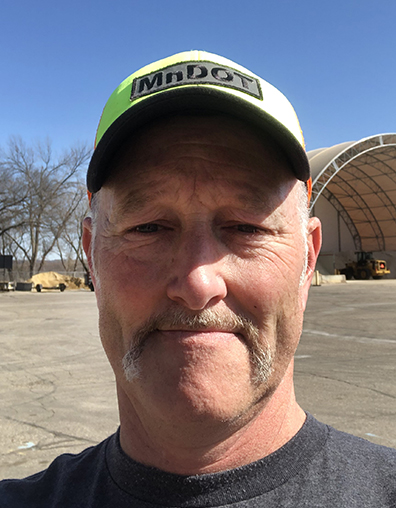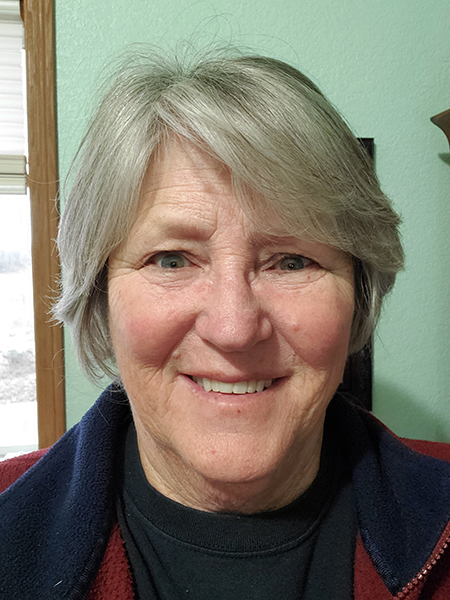By Joseph Palmersheim

Brian Sisell, transportation generalist, wipes down a snowplow at the Lakeville Truck Station March 10, 2021. One of the safety protocols in place during the pandemic has been to “wipe in, wipe out” in order to sanitize the interior between uses. (Photo by Robert Hendel) |
While more than 30 percent of MnDOT’s workforce continues to telework (down from a high last spring of around 50 percent), the majority of the agency’s workers have been reporting for duty in the field, lab or office throughout the COVID pandemic.
But work has not been business-as-usual for those continuing to report to their regular work locations. New protocols, on top of standard safety practices, are now in place to get the job done: One person per truck (later raised to two, with both wearing masks). Social distancing. Vehicles disinfected on the way in and the way out. Multiple crew shifts. Lunch rooms expanded into truck bays. More facility cleanings.
There are the daily health screenings.
And masks. Always masks.
The realization last year that COVID-19 was going to change things hit people at different times. For Ben Boldt, transportation operations supervisor at the Red Wing Truck Station in District 6, that realization came when Gov. Tim Walz started talking about a state Stay at Home order.
“We were concerned we were going to be a part of it,” Boldt said. “That was when it really hit for me, after being here so long, that life as we knew it was taking a different turn.”

Ben Boldt. Submitted photo |
Derrick Crews, Austin subarea supervisor in District 6, recalls preparing for ditch work last spring when a meeting with a management team spelled out the unknowns.
“It was almost like doomsday - somebody around might get this and maybe die from it,” he said. “That was a scary thing, having those meetings every week. Trying to keep the crew safe and distanced and still trying to do your job.”
“Some days, it was hard to keep morale up when the world seemed to be crumbling,” said Robert Hendel, a supervisor at the Lakeville Truck Station in Metro District. “We stopped turning the news on at noon.”
A year on, MnDOT workers are still reporting to the field, preparing for another season of summer maintenance work and construction. And while the past year’s uncertainty may have lessened, the challenges won’t be forgotten.
Todd Stevens, maintenance engineer, Metro District, said that MnDOT’s field workers aren’t strangers to risk: they stand on roads with 70 mph traffic 6 feet away, or driving a plow on icy roads in a blizzard.
“A lot of people look at this as just another risk,” Stevens said of the pandemic. “Obviously, it’s a different risk with different consequences, but one more risk they have to consider.”

Kathy Hokkala. Submitted photo |
Stevens has been teleworking for the past year. But with around 500 direct reports still in the field, he misses being able to connect with people face to face.
“It's important to get out into the field and talk to those workers in their place, and with that not being an option, it's been frustrating,” he said. “I'm not saying it affected our ability to get work done, but there's a relationship between management and front line, and I think that's taken a hit because of no face-to-face contact.”
Not being face-to-face can present other challenges, too. Kathy Hokkala, a transportation generalist based in the Hutchinson construction office in District 8, spent part of the last year teleworking and part in the field. When she was in the field last summer, she worked with contractors and vendors as a plant monitor for concrete and bituminous plants. But there was a twist – she had to do it through her phone, using FaceTime.
“In the bituminous plants, when they run the tests, we have to watch the whole test,” she said. “There’s a whole series of different tests that they do, and the samples are all weighed out. And when you aren’t physically there watching, they have to somehow show us that they did that. It was difficult, because they are showing you a number on a scale. When you are there, you can watch the whole thing.”
Hokkala works by herself a lot of the time in the field labs running the gradations for concrete materials. Bumping into other people using the labs during the pandemic was a bit strange, she said, and like many of her peers, she had to adjust to wiping things down all of the time.
“It's a whole different routine that you get into,” she said. “It was more of a challenge to make sure everything was done correctly. I'm glad it’s passed, and hopefully we can get to the new normal.”

Rob Hendel. Submitted photo |
Others noted the impact of having to physically distance. Boldt and Crews miss the in-person meetings.
“It’s a social thing as well as a learning experience - getting together with your peers and being able to exchange ideas,” he said. “Everything now is on the phone or a Teams meeting, and that's been a challenge. A lot of hands-on training, or what used to be, we haven't been able to do.”
“It will be good to get back to seeing to people and having meetings in person again,” Crews said. “I was sick of them before this, but now I miss them.”
This affects not only the people who work for MnDOT now, but also potential employees. Hiring during a pandemic means everything is done via phone for interviews, versus being face to face.
With the changeover to a new season, there is some optimism in the air, Boldt said. He noted that there is a hands-on class for chainsaws in May – a sign of progress.
“People are seeing the light and the optimism is starting to get up there,” he said. “Optimism that we can start getting back to our normal day-to-day operations. Everyone's looking forward to being able to work with each other and not be so socially distanced.”
For Stevens, the past year has reinforced the importance of everyone at MnDOT understanding the perspective of those working in the field.
“The decisions I make directly affect people out in the field, and the level of safety they have out in the field. [We] need to understand what they are worried about,” he said.
Crews, who is looking forward to sweeping operations this spring, thinks he’ll look back on the past year as “a weird time in history for us.”
“It was really unbelievable what happened here for a year – it was a change for everyone in the whole world,” he said. “No one thought this would last a year. I thought it would be a few months, then it turned into six, and now we’re a year into it.
Hendel agreed.
“The moods in the shop are progressively getting better,” he said. “We see a light at the end of the tunnel, hopefully,” he said. “The past year was a good learning experience for everybody, and I think everyone is now aware we can adjust to drastic changes and still succeed, still get by. It threw us a few curve balls - but we still got the job done. We have good, hardworking crews.”
| 


